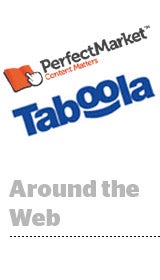 Content recommendation engine Taboola has acquired Perfect Market, which develops a publisher-side solution designed to improve engagement, driving traffic, and monetization. Taboola CEO Adam Singolda wouldn’t disclose the deal’s terms, though he said it was a mix of cash and stock.
Content recommendation engine Taboola has acquired Perfect Market, which develops a publisher-side solution designed to improve engagement, driving traffic, and monetization. Taboola CEO Adam Singolda wouldn’t disclose the deal’s terms, though he said it was a mix of cash and stock.
With the acquisition, Taboola will change from being a content discovery engine to being a content and product discovery engine. “We work with thousands of publishers, and the industry is looking for more innovation around monetization across the board,” said Singolda. Taboola will answer those publisher concerns by integrating Perfect Market’s monetization product, Perfect Ads, into the Taboola platform. The technology will power Taboola-X, Taboola’s first programmatic ad solution, which will serve both the buy and sell sides. Since Perfect Market and Taboola have shared publisher partners before, that has “allowed both companies to collaborate on the potential value that can be created by having both products integrated on a page,” Singolda said, and give the company a head start in combining the two technologies.
The Perfect Ads platform decides what sort of ad content to serve based on user signals, like how the user arrived on the page or device type.
“If someone is on their mobile device, it might be better to serve them an article recommendation, but if they’re on the desktop and came in through search, it may be right to serve them a product ad,” Singolda said.
User information collected across Taboola’s network – like what kind of products they may like, and whether the algorithm predicts the user is in the mood to buy – enable further ad customization.
Taboola-X will change the look of Taboola’s placements. If a publisher opts-in, a user will see advertisements next to article headlines. It will also change the marketplace. By adding product ads into the mix, publishers seeking wider distribution of their content will compete against product ads for placement. Links to content have lower CPCs but higher CTRs. Product ads have the inverse, higher CPCs but lower CTRs. That means they may have roughly analogous RPMs, or revenue per mille, according to Singolda. RPM determines which content ends up in Taboola’s widget.
A publisher that is trying to drive eyeballs to content on their site would continue to use the traffic acquisition feature to monetize those ads. But if they wanted to drive users to a newsletter registration landing page, for example, they would go through Taboola-X.
With this product, Taboola also hopes to migrate sideways and upwards from its standard placement below the fold at the end of the article. Publishers could place ads running paid content as an above-the-fold banner or as a right rail unit, allowing “full page monetization” through Taboola, Singolda said.
According to Singolda, reactions to this offering have been good so far. “We were always about discovery,” he said. Taboola-X will allow the company to use its technology to surface relevant products as well as relevant articles.
Post-acquisition, Perfect Market’s publisher tools around traffic and engagement may also end up as part of Taboola’s product suite for publishers.
Perfect Market has 25 employees, down from 60 employees when AdExchanger interviewed CEO Julie Schoenfeld last April. They will join Taboola’s team.
With the acquisition, Taboola expects to have a $250 million run rate for the year, which would represent a 150% growth from 2013.













